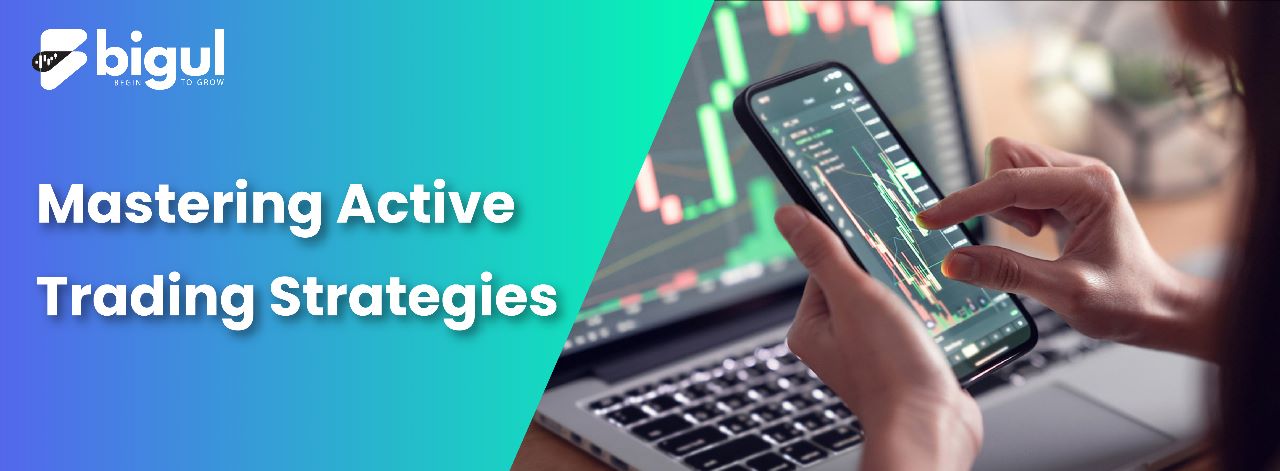In recent years, stock market trading has shed its reputation as a mere gamble, transforming into a respected profession requiring dedication, research, and unwavering attention.
Thanks to technological advancements, trading has become more accessible, empowering traders to take control with the aid of sophisticated tools and platforms.
For aspiring active traders, this presents a golden opportunity to enter the market and capitalise on its frequent movements. Today this post will cover the best 5 trading strategies to assist you in starting trading and making money every day, week, and month.
What is Active Trading?
Active trading involves frequent buying and selling of financial instruments to capitalise on short-term price fluctuations in highly liquid markets. Traders seek to profit from these price swings by engaging in speculative trades, predominantly in stocks and derivatives with substantial trading volume.
Employing various order types, such as stop-loss and take-profit orders, allows them to proactively manage risk and secure profits.
Active traders rely heavily on comprehensive research, analysis, and technical tools to identify trends, make informed predictions, and strategically implement their trading strategies.
Success in active trading demands a keen understanding of market dynamics and the ability to swiftly adapt to changing conditions.
Now you must be thinking, how many types of trading are there in India? There are 4 types of trading: day trading, positional trading, swing trading, and scalping. We will discuss all of them in our next section on active trading strategies.
Types of Active Trading Strategies
Active trading involves several strategies traders can employ to maximise profits and manage risks effectively.
A well-defined trading plan is crucial for implementing these strategies systematically. Below are some common types of active trading strategies:
Intraday trading is also known as day trading. It involves purchasing and selling shares in one trading day without holding any positions overnight.
In markets like India, intraday trading occurs between 9:30 am and 3:30 pm. To excel in intraday trading, traders must exercise caution and avoid blindly following unverified tips. Instead, they should rely on well-researched advice from certified investment advisors.
Understanding the timing of market entry, setting a precise target and stop-loss levels, and utilising appropriate order types are essential for success.
Additionally, selecting liquid stocks for investment is crucial, as illiquid ones can hinder quick transactions. Proper research, discipline, and risk management are key factors in achieving profitability in intraday trading.
Positional Trading
Positional trading involves analysing long-term charts and market data to identify market trends, with trade durations spanning from days to weeks or even months. It is often perceived as a buy-and-hold strategy, where traders ride the trend, exiting positions only when the trend reverses.
Trend traders rely on consecutive lower lows or higher highs to determine the trend direction and aim to profit from both upward and downward movements.
However, high volatility can present significant challenges when implementing the positional trading strategy, as it may increase the risk of sudden trend reversals and unpredictable price swings.
Here are some risks associated with positional trading:
- Long holding periods may tie up capital for extended periods.
- Increased exposure to market risks due to prolonged market exposure.
- Potential for missed opportunities in rapidly changing market conditions.
- Requires high patience and discipline to stick with long-term positions.
- May result in higher trading fees and costs due to infrequent trading activity.
Scalping
The scalping trading strategy is a rapid active trading strategy employed by traders to capitalise on narrower or wider bid-ask spreads resulting from supply-demand imbalances. It involves buying a stock at the bid price and quickly selling it at the asking price to make small profits.
Trades typically last under 5 minutes, and traders focus on increasing the number of trades rather than aiming for substantial gains.
Scalping does not require a predefined exit strategy or specific profit goals, making it suitable for those seeking quick, frequent, but smaller returns.
Swing Trading
Swing trading involves holding a security for more than a day, often for several weeks, to capitalise on the start of a new trend after the previous one ends.
Traders use fundamental and technical analysis to create rules or algorithms for buying and selling.
Due to increased price volatility, the strategy exposes them to higher risk during sideways or range-bound market conditions.
Swing traders aim to profit from short-to-medium-term price movements, with positions lasting several days but shorter than trend trades. It’s important to select the right stocks for swing trading. Here is how to select stocks for swing trading:
- Identify stocks with high liquidity and trading volume for easy entry and exit.
- Look for stocks with strong price momentum and clear short-term trends.
- Conduct technical analysis to identify key support and resistance levels.
- Use fundamental analysis to assess the company’s financial health and growth prospects.
- Set clear entry and exit criteria based on risk-reward ratios and stop-loss levels.
- Stay updated with market news and events that could impact the selected stocks.
Remember, swing trading involves taking a more short-to-medium-term approach, so it’s essential to be disciplined and execute trades according to your predefined strategy and rules.
Conclusion
Active trading strategies provide traders valuable tools to navigate the fast-paced world of short-term market movements. From technical analysis and trend following to risk management and diversification, employing these strategies can enhance the chances of success.
However, choosing the best trading platform in India is crucial to execute these strategies effectively.
A reliable platform with advanced features and real-time data can empower traders to make timely and informed decisions, ultimately maximising their potential for profitable outcomes in the dynamic Indian stock market.

.jpg)






.jpg)
.jpg)
